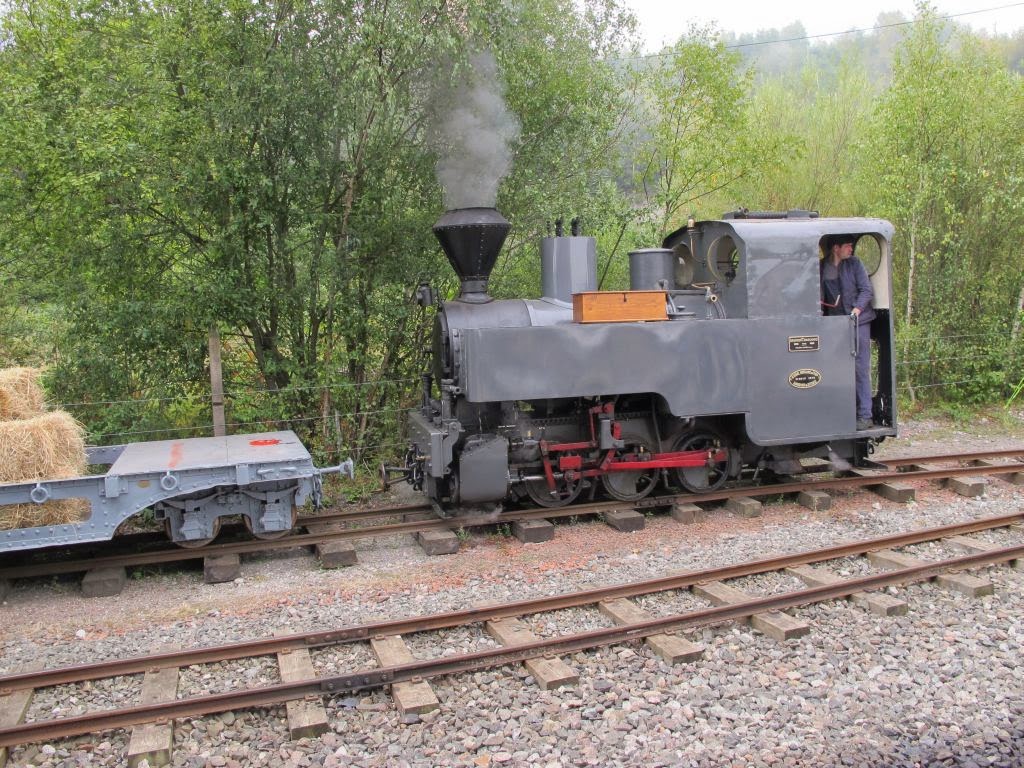Today was even better weatherwise, and Ivan, Malc and I set off on the little bikes (two 7hp C90s and an SS50, in contrast to my Griso's 120hp) to visit the Foxfield Steam Gala, which I last visited on 22nd July 2012 (see the blog). We stuck to the small roads that suit these bikes best; Chelford, Jodrell Bank, Lower Withington, Congleton, east of Biddulph Moor, Rudyard, Longsdon, Cheddleton, Wetley Rocks, Cellarhead, and Caverswall to the railway.
It's food for thought that on a back roads trip like this, the difference in journey time between the 7hp C90 and the 120hp Griso is only a few minutes. But the Guzzi sure sounds better!
Having locked up the bikes and paid our entrance fee we had a look round the Caverswall Road site.
The railway was built to bring coal out of Foxfield colliery (which closed in 1965) to the main line at Blyth Bridge. Caverswall Road is the railway's main site, from where passenger trains run to Dilhorne Park. Freight trains run through to Foxfield Colliery, but the gradient between Dilhorne and Foxfield is in places as steep as 1 in 19; the steepest adhesion-worked standard gauge line in Britain and too steep for passenger trains.
As usual, please click on any picture for a larger image.
This 1947 Peckett locomotive on show at Caverswall Road (though not in steam) incorporates many advances in industrial locomotive design made during the steam era.
Here's an old friend - the Beyer Peacock saddle tank that spent some time at the Churnet Valley Railway recently (notably at the Winter Steam Gala on 22nd February this year - see the blog). Its train comprises the restored Knotty (North Staffordshire Railway) 4-wheel coaches - and very smart they are. Malc and I saw one of these coaches at Cheddleton Sunday 24th June this year, as reported in the blog for that date.
We boarded a vintage Knotty coach fro the trip to Dilhorne Park. The recent restoration is to a very high standard; even the slots in all of the heads of the brass wood screws are vertical!
Ivan and Malc observing the rural countryside go by the window between Caverswall Road and Dilhorne Park
Our train arrives at Dilhorne. From here we will walk the rest of the way to Foxfield colliery.
Malc goes over the stile, Ivan next, as we join the footpath down alongside the railway to the colliery
'Woolstanton No.3' on the back of the train
Halfway to the colliery is 'leg-over stile', so called because some elderly gentlemen with arthritis can't get their leg over here! We managed OK, though. When I was last here, 2 years ago, this path was far too muddy to negotiate, but after our lovely dry late summer and autumn this year it was dry as a bone. Ivan and Malc having managed it, that's all of us over.
On arrival at Foxfield Colliery we watched some shunting, including these two wagons being let down the bank without use of a locomotive. Here's a video:
Eventually the train was assembled and climbed the bank. It's headed by 'Florence No.2', an 0-6-0 Bagnall from Florence colliery, Staffordshire. She is fitted with a Giesel Ejector, which may have improved performance but does mean the exhaust is somewhat 'soft'; a tad disappointing on the bank. The colliery head gear can be seen in the background. The video is below:
A shuttle bus was provided between Caverswall Road and Foxfield colliery. We caught it back to Caverswall Road.
By the time we got back to Caverswall Road the crane tank and train were there having worked down from Dilhorne Park
Here's a locomotive we've met before on this blog, well tank 'Bellerophon'. She was one of six built in 1874 for Haydock Collieries and is the sole survivor. Unusually for such an early locomotive she has outside Stephenson / Gooch valve gear and piston valves.
We took a ride behind 'Bellerophon' , once again in the vintage Knotty stock up to Dilhorne Park and back. Here's another view of the surprisingly rural scenery on this former industrial line.
Back at Caverswall Road we prepare for the ride home. Malc with his and my Honda C90s, Ivan's SS50 behind them.
We rode back the same way as we had come, stopping for fuel at Chelford and for a lovely pint of Sam Smiths bitter at the Bird In Hand, Knolls Green.
So ended yet another great day out on manouvres for us on the little bikes.
.


















































